Massacre at Friendship (The Raid on Meduncook)
According to the family legend from the Bradford Family of Charlotte Co. (New Brunswick) and Washington Co. (Maine), there was a terrible event that occurred at Friendship, Maine in the late 1750s. The area was then called "Meduncook" but was later changed to "Friendship" because of the horrible association the former name had with the Native people of Maine. "Friendship" signified a new beginning to the people of Maine and gave closure on this unfortunate event.
The story, according to oral legend, is that Joshua Bradford, a great-grandson of Gov. William Bradford of Plymouth, Massachusetts, was brutally murdered at the hands of Indians while living at Friendship. A few years prior to this event, Joshua, along with his wife Hannah, settled the area after leaving the area of Plymouth. Sometime in a winter, during these earlier years, Joshua saved a man who had fallen through the ice, that man was actually a local Penobscot Indian chief. The two men formed a friendship. During the settlement of Friendship, the British erected a garrison on a small island in the harbor, just off the point from where the Bradford family had their homestead. The island was accessible to the mainland by foot when the tide was low. Early in the morning of May 22, 1758, a group of Indians, not from the area, proceeded to Friendship. On route to attack the garrison via the point, they came across the homestead of Joshua Bradford. Seeing the approaching Indians and believing that they were of the same tribe as the Chief that he befriended, Joshua did not take heed of the alarm shots coming from the British Garrison. Most settlers in that area where living safely at the Garrison for some time. The Indians attacked Joshua, killing him and his wife Hannah. Some suggest that they were brutally scalped! One of the Bradford children, an infant son (Winslow), was also killed as was another local woman (Mrs. Mill) and her child. The other Bradford children hide in the homestead. One daughter (Melatiah Lydia) hid under the bed with a younger brother (Elisha). When the young child cried, she took him and made a dash for the Garrison. The Indians gave chase and succeeded in striking her in the back with a tomahawk. She managed to continue to the Garrison where she, and the younger child, was escorted to safety. She survived her wounds. Witnessing these events, the men of the Garrison took up arms and went out to rescue to the Bradford family. Before fleeing, the Indians took two of the Bradford boys (Joshua II and Benjamin) with them. The surviving Bradford children were recovered and taken to the Garrison.
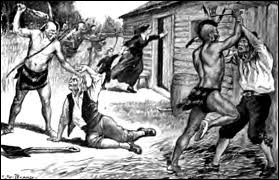
The Indians took the two Bradford boys and continued to move north. Some say that they boys were taken as far north into what is now the Canadian border area of St. Croix and Downeast Maine. The boys were given little to eat by their captures and left to gather their own food. On one occasion, the boys were caught stealing bread from a settler's homestead. After convincing the settlers that they were prisoners of Indians, they were given a map to get them back to Meduncook and so they fled back along the coastline of Maine, eventually returning after being held by the Indians for some time.
The wounded daughter (Lydia) eventually married and raised a large family in Vermont. The two boys that were taken captive also went on to raise large families. Joshua Jr. married and raised his family in the area of Friendship. Benjamin moving to Canada with the British Loyalist in the 1780s. He settled outside of the town of St. Andrews, Charlotte Co., New Brunswick and had at least eight children. The younger Bradford children were sent to family in Plymouth Co., Massachusetts. Those that were killed at this event were buried on the island. With the passage of time, their headstones were lost (likely used as ballast in a ship). As well, the remnants of the Garrison slowly vanished. For decades, local Indians refused to travel to the area. Garrison Island is now privately owned by the Carlson family.
So this was the story according to the folklore of the Bradford family in Charlotte Co., who were descendants Benjamin, one of the boys held captive by the Indians.
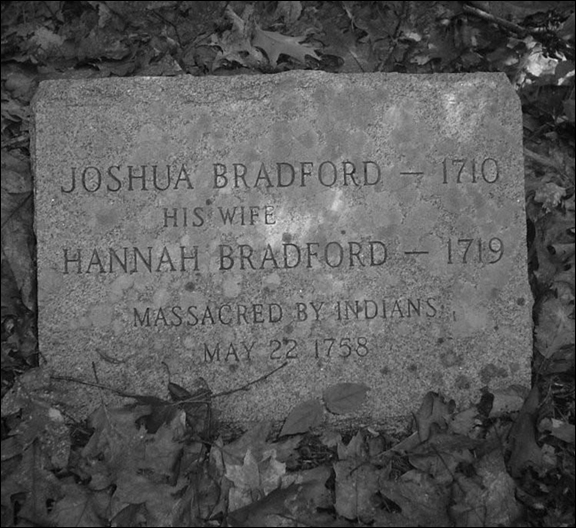
Photo of Joshua & Hannah Bradford's "Memorial Stone"
Photo by Margaret (Watton) Gagnon, Friendship ME in 2011.
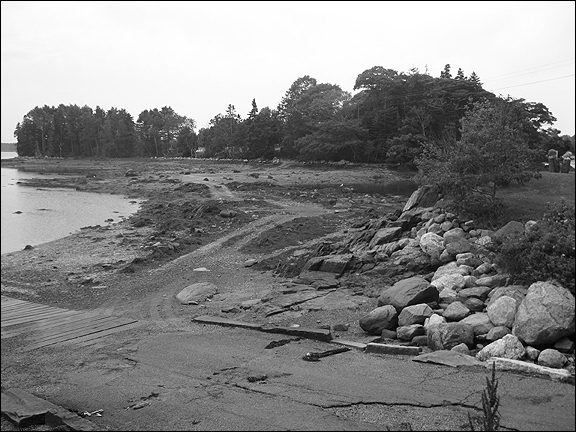
Photo from Bradford Point looking at Garrison Island at low tide
Photo by Jason Gaudet, July 2012

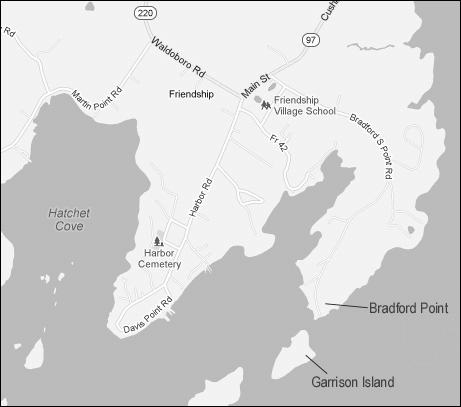
|
Friendship, Maine is located in Knox County, along the south-central coastline. It is approximately 25 minutes east of Rockland and 60 minutes south of Augusta.
For a further reference, visit Google Maps by clicking here!
|

Additional Information:
According to Wikipedia (2012) regarding the "Raid on Meduncook (1758)" on the subject of "Friendship, Maine":
During the French and Indian War, the community was raided twice. The first attack was from Indians just after sunrise on May 22, 1758. They killing and scalped Joshua and Hannah Bradford and their infant son Winslow. An original settler from Kingston, Massachusetts and great-grandson of Governor William Bradford, he had remained in his house, believing it close enough to the garrison that his family could flee there when necessary. But while pounding corn, the Bradfords missed hearing the garrison's alarm gun. Five of their children managed to escape their pursuers into the fort, but two of their sons Cornelius (21) and Joshua (12) were captured and carried to Canada. After trying to lay siege to Thomaston, Maine in September 1758, a party of Indians and Acadians under the command of French Officer Boishebert raided the village. Eight British were captured or killed.
History of Friendship, Maine (A Gazetteer of the State of Maine; By George J. Varney, 1886):
Friendship was a part of the Muscongus or Waldo patent, and the original deeds are from General Waldo. The Indian and the plantation name of the town was Meduncook, signifying "Sandy Harbor." Yet the term seems inappropriate, for the shore is rock-bound, and in some parts are bold bluffs where ships may ride at anchor in safety in 20 feet of water. The first settlements were in 1750. About this date a garrison was erected on an island in the southern part; which, from this circumstance, bears the name of Garrison Island. It is connected with the main at low water. James Bradford*, who was one of the first inhabitants, settled near the fort. In 1754, there were resident here 22 families, among whom occur other names as follows: Jameson, Wadsworth, Davis, Lowry, Gay, Cushing, Bartlett, Dernorse, Bickmore, Morton and Cook. In the war of 1755 all moved their families within the garrison except Bradford, who believed he could easily reach it whenever Indians should appear. One morning while he was engaged in pounding corn, the watchers in the garrison saw savages approaching the house, and at once fired a gun to alarm Bradford's family. None of them heard it, and the savages entered the house and killed Mr. Bradford and his wife with their tomahawks. As her infant fell from her arms, a daughter some twelve or fourteen years old, sprang from her concealment under the bed and caught the infant as it fell, instantly running away with it toward the garrison. The Indians pursued, flinging their tomahawks after her. One of these made a deep flesh wound, yet she reached the garrison still holding the infant. The girl recovered from her wound, and, removing to Vermont, became the mother of a large and respectable family. (*Note: "James Bradford" is likely mistaken name for "Joshua Bradford")
Special thanks to: Margaret (Watton) Gagnon, Rebecca "Beca" Lehr, Thomas H. Moody, Peter Burrows, Jane Carlson and the Carlson Family at Garrison Island, and the Friendship Museum.

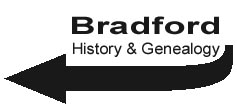
Updated: 21 September 2016
www.HeritageCharlotte.com/Bradford/
Copyright ©2006-2021 Jason N. Gaudet/Heritage Charlotte All rights reserved










